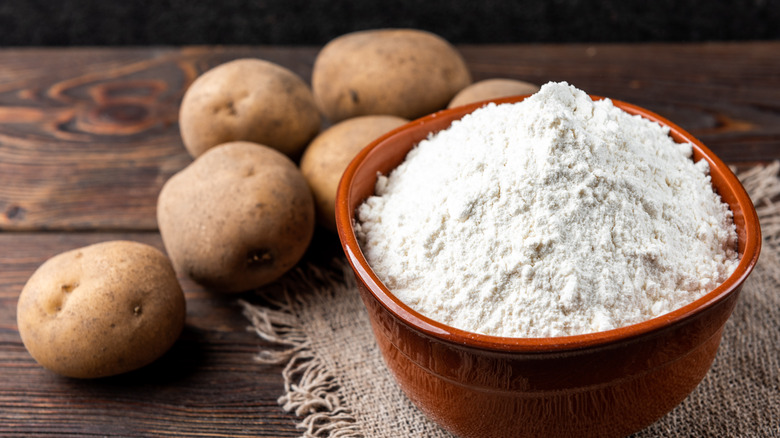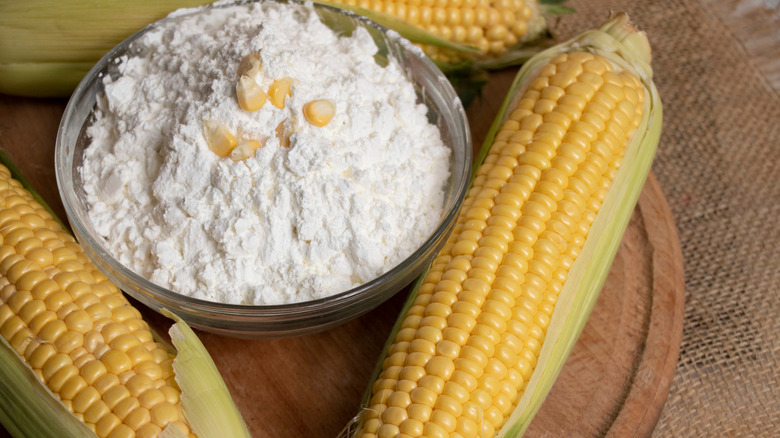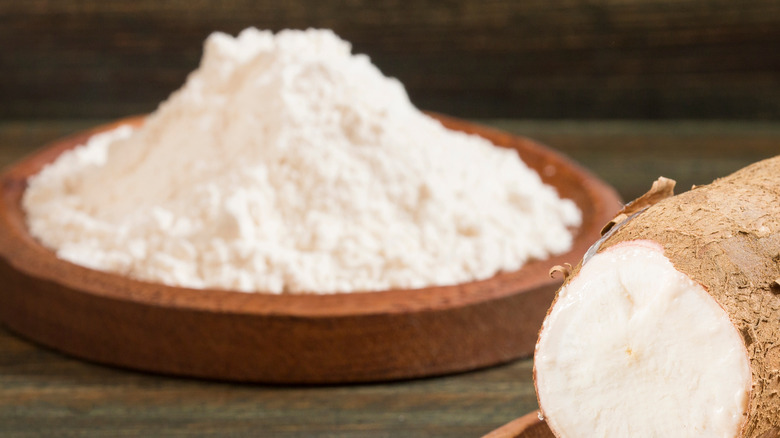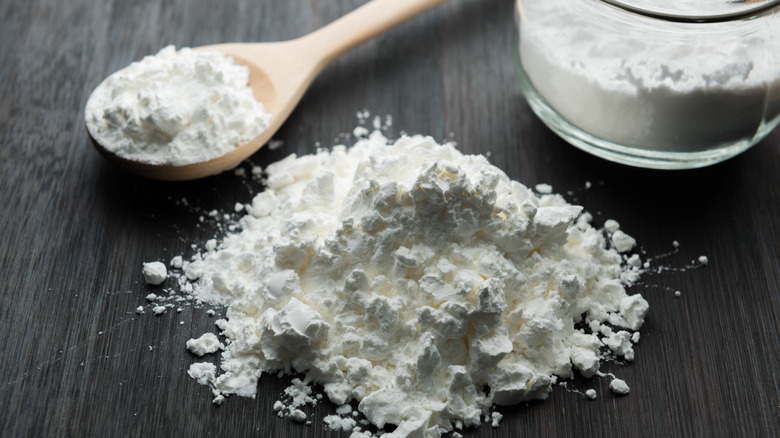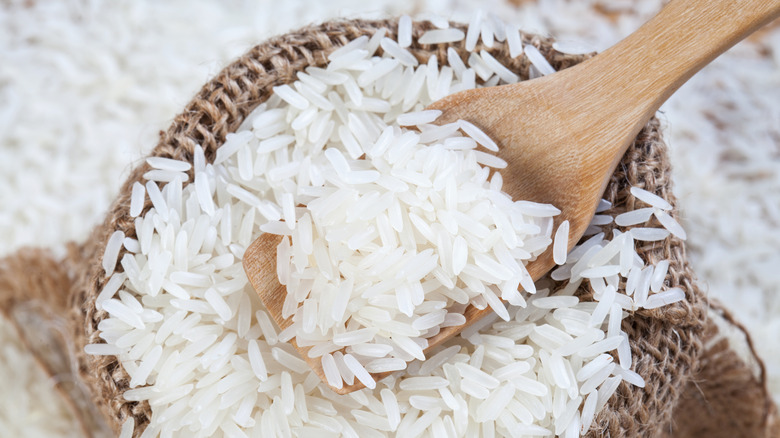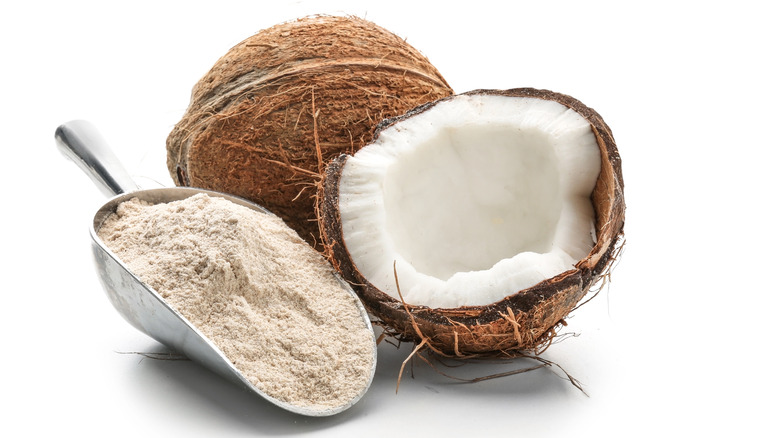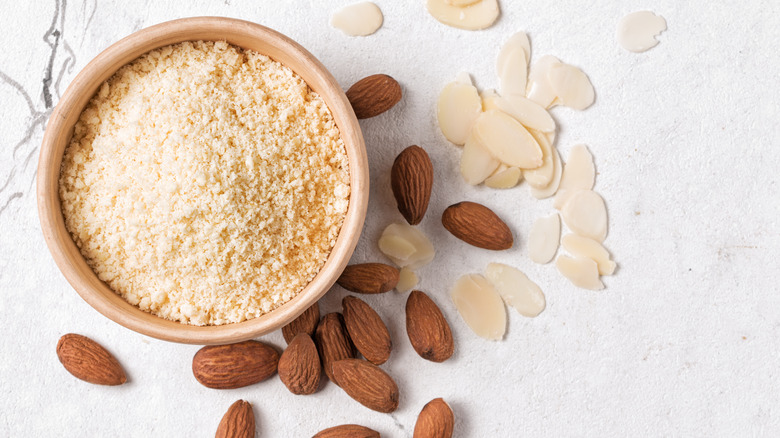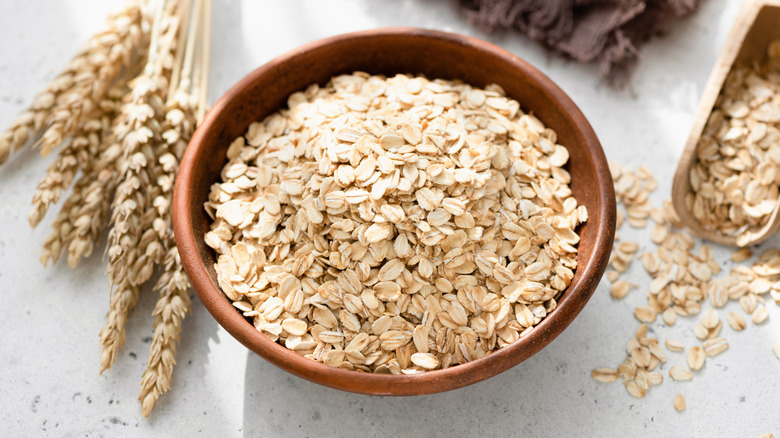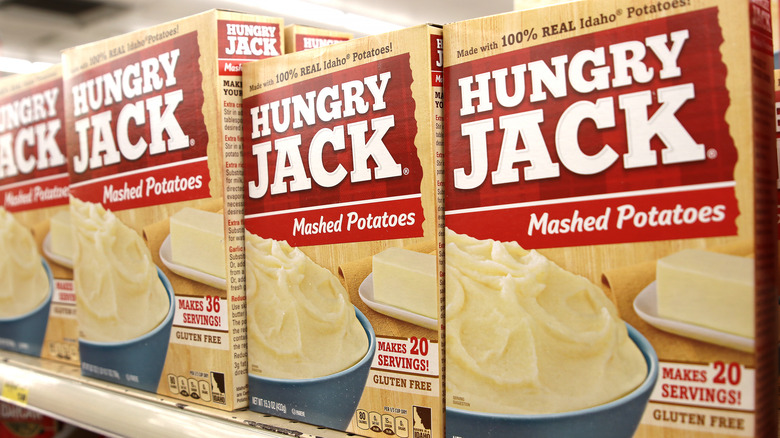10 Best Substitutes For Potato Starch
Potato starch is, not surprisingly, a starch extracted from potatoes. It's a great gluten-free alternative option for use in many recipes, according to Medical News Today. Potato starch is made by crushing raw potatoes and then separating out and cleaning the extracted starch grains from the broken cells of the potato. Once dried and processed into a powder, it is an easy-to-use ingredient that works much like wheat flour in some recipes and can be used in place of other types of starches in even more applications.
Potato starch is often referred to as potato flour, but for the record the two are distinct and cannot always be used in place of one another, nor can potato starch always stand in for flour. According to Taste Essence, whereas potato flour results from grinding, drying, or cooking entire potatoes, potato starch comes from processing just the starchy part of the potato.
So don't confuse potato starch and potato flour, to put it more simply, because they are not the same thing. Do, however, plan to use potato starch in the place of other starches. On the other hand, if you have a recipe that calls for potato starch yet you don't have any on hand, there are many options you can use in its place.
Here are 10 great substitutes for potato starch.
1. Cornstarch
Arguably the most common of all the starches, cornstarch makes a fine stand-in for potato starch in all sorts of different recipes. It can act as a thickener just like potato starch often does in sauces and stews. It can be used in baked goods. It can be used to line a pan headed for the oven, and so on. And as cornstarch has no discernible flavor – the same being true for potato starch – it can be used as a direct swap (via Spiceography).
In other words, if your recipe calls for potato starch but you have cornstarch instead, no problem at all: carry on exactly as you would albeit with that alternatively sourced starch. And in fact, in many cases, cornstarch is an even better choice, as it can endure longer cooking times than potato starch without breaking down. Just note that attribute and consider adding it a bit earlier in the cooking process when doing so won't affect the order of adding other ingredients.
2. Arrowroot flour
Healthline describes arrowroot (Maranta arundinacea) as a root vegetable found in the tropics. Indigenous to Indonesia, the starchy tuber is normally turned into a powder that may be referred to as arrowroot flour or arrowroot starch. It is a good source of protein and a few key nutrients, and it is very easy to digest. When preparing food for children or elderly people with sensitive digestive systems, arrowroot is a great choice.
And according to Greedy Gourmet, arrowroot starch is a go-to option for gluten-free and vegan diets. The site also describes it as "an excellent" replacement for potato starch in recipes.
When you substitute arrowroot starch for potato starch, it's a good idea to use a bit less of the former: aim for a 2:3 ratio, which is to say, replace three teaspoons of potato starch with just two teaspoons of arrowroot starch.
3. Tapioca starch
According to Healthline, "tapioca is almost pure starch," and thus it is of almost zero nutritional value. But when it comes to cooking, that also means it's a great sub for potato starch, as it will impart almost no perceptible flavor to any dish in any application, whether you use it to thicken a sauce or dressing, you add it to baked goods, you mix it into a breading, and so forth.
Sourced from the cassava root, which is native to South America, tapioca is generally easy to find in any sizable grocery store, and it can be ordered online as well. As you will find with most starches, tapioca is gluten-free, it's generally not an issue for anyone with allergies. For most recipes, you can do a direct switch out of potato starch for tapioca starch, according to Simply Gluten Free.
Since tapioca isn't as dense as potato starch, Spiceography suggests adding another quarter-cup of tapioca starch for every two cups of potato starch. It's a good idea to add tapioca starch a bit later in the cooking process, if possible, as it breaks down more than potato starch, especially when acidic ingredients are present.
4. Wheat flour
Wheat flour, meaning the classic all-purpose flour you use to bake cakes, make various types of bread, in preparing cookie dough, and so on, can be used in place of potato starch in many applications, especially when the purpose of the starch is as a thickener. It can be used as a one-for-one substitute in most applications, according to King Arthur Baking, but keep in mind that using wheat flour instead of potato starch does have a few drawbacks.
For one thing, when introduced to liquid, wheat flour can clump up into stubborn bits not easily broken up, so you need to add it more slowly than you would with potato starch. Also note that potato starch will absorb fluid more quickly than flour. And then there is of course the fact that wheat flour has gluten, and many people turn to potato starch and other such options as a way to avoid gluten in the first place.
5. Rice starch
Rice starch is usually created using broken grains of white rice, according to Britannica. It can be used in place of potato starch in many recipes, having no perceptible flavor and having very similar characteristics to potato starch in most cooking applications, including use to thicken liquids or as a component of a baked good or a breading. Rice starch is also very useful for thickening foods that will be served cool or cold, such as puddings or custards, according to an article published in Food Science and Technology (via Science Direct).
Beyond its potential in the kitchen, rice starch is widely used in commercial applications as well. Most of the starch used in the laundering and preparing of clothing is rice starch – when you think of a stiffened collar or a crisply pressed dress shirt, it is most likely rice starch that is helping the garment hold its shape.
6. Coconut flour
According to Gluten Free Living, coconut flour is naturally devoid of gluten and has contributed to a larger surge in coconut popularity. It can be used in place of many other types of flour and starch, including potato starch, in many cooking applications, and coconut flour performs particularly well when blended with other starchy options, such as a blending of coconut flour and cornstarch.
Unlike potato starch (and many starches) coconut flour does have some taste to it, in particular a sweetness, so it is not a suitable stand-in for potato starch in all cases. But in many recipes, a bit of added sweetness is a welcome thing, such as in baked goods, in certain sauces, and even in some soups. Also do note that you will want to use less coconut flour than the amount of potato starch a recipe calls for, as it is very absorbent and can dry out some dishes, according to Nourished Kitchen. Add small amounts at a time to see how the cooking is affected (or not) by the ingredient swap.
7. Almond flour
You can use almond flour in place of potato starch in many foods, and it will work particularly well as a substitute in baked goods such as cakes and cookies. However, almond flour has different characteristics than most starches when used in many cooked foods (for instance, due to its fat content, almond flour tends to retain moisture, per Chowhound), so approach each recipe with care if you will be roasting, frying, grilling, or otherwise cooking the dish.
And don't confuse almond flour with almond meal, as they are quite different from one another. According to Minimalist Baker, "Almond flour is made from blanched almonds without skins as opposed to almond meal, which is made from raw almonds with skins," has a rougher texture, and makes for heartier dishes.
8. Oat flour
According to Simply Oatmeal: "Oat flour is finely ground from whole oat groats," which consist of kernels that were separated from the oat husks. Since a whole grain served as the starting point, oat flour will provide the vitamins, fiber, minerals, and protein present in oats. Thus it is significantly more nutritious than potato starch.
Oat flour, not surprisingly, handles more like wheat flour than like a purer starch, so it must be added to liquids slowly and with lots of stirring to prevent clumps. It is a good choice for use in baking, but it may prove too thick for use in some dishes (via Okonomi Kitchen), so use care when making the substitution. And of course, do not confuse oat flour with oatmeal – the latter will perform nothing like a starch.
9. Potato flour
According to King Arthur Baking, potato flour is about 83% starch, and thus it can be used in place of potato starch (and other starches) in many recipes. While it won't perform exactly the same as the starch, given that potato flour has fiber and protein and can make baked goods a bit more chewy than pure starch alone, it's a decent substitute in a pinch, and it's gluten-free.
One thing to note about potato flour vs. potato starch is that the former has a more pronounced flavor and will impart a potato taste to many dishes. That's not necessarily a bad thing, but it should be noted. Go for a one-to-one ratio for this substitution.
10. Instant mashed potatoes
Instant mashed potatoes may seem an odd choice to use as a thickener for a soup or sauce, as part of bread or another baked good recipe, or to use in making a coating for fried meats, but really they are just like potato flour in slightly less processed form. To that end, make sure you process instant mashed potatoes in a food processor, high-speed blender, or even in a coffee grinder (in small batches) before using them in place of potato starch, as you need to refine the larger flakes down into a powder (via Cooking Chew).
Once you have finely ground the instant mashed potatoes, you are essentially dealing with potato flour, albeit quite likely with a much higher sodium content, so keep that in mind as you plan your recipe.
